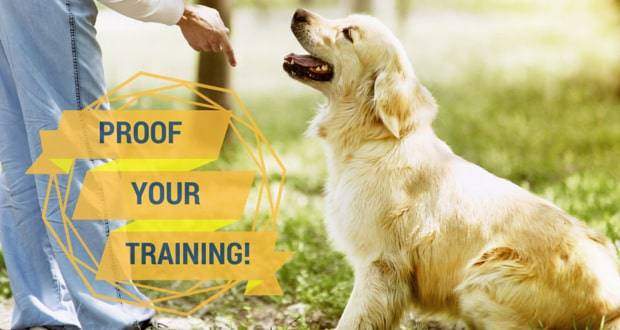Updated: August 9th, 2022

© Depositphotos.com / solovyova
Many owners will be familiar with that sinking feeling you get when you’re in a new environment and your dog forgets all their diligently worked training, appearing to regress back to puppyhood.
If you’re wondering why your dog seems not to listen to you when you’re out and about, then wonder no more – you have neglected to proof your dog’s training.
Dogs have an inability to generalize well, and proofing is the answer.
Without proofing your Golden Retriever’s training it will likely be forgotten outside of the environment they learned it in. This will mean you’ll find it harder to control and manage your dog when you’re out and about.
All is not lost, however – there are always opportunities to proof your dog’s behaviors and even teach them how to generalize better so every skill they learn, they can perform no matter where they are or what distractions happen to be nearby.
What Actually Is Generalization?
One big difference between humans and “man’s best friend” is the ability to generalize.
We, as humans, take it for granted that a behavior learned in one environment can easily be transposed and practiced in another environment. For instance, once we have learned to ride a bike, we can ride anywhere we like – parks, the sidewalk and even mountains.
Dogs, however, are unable to link together their training with a new environment. This is why they can perform the behavior for the ‘sit’ cue in your kitchen, where they originally learned it, but are unable to perform the behavior at the park or when someone else is cueing them.
To continue with the human metaphor, it’s as though your dog can only ride a bike in the park that you taught them to ride in, under the same circumstances. They would need to be taught to ride again on the sidewalk or the mountains.
Just because your dog can’t perform an asked for behavior in new environments doesn’t mean they’re disobeying you. Rather, they simply don’t understand the cue in these different environments because of their inability to generalize. Quite simply, their brains work differently to ours in this respect.
How Do We Teach Dogs to Generalize?
We can encourage our dogs to generalize by extending the parameters of their training. The aim is to teach your dog that when you cue them to perform a behavior, it means the same thing “regardless of the scenario or environment you are in” (– to borrow a definition from Dogmantics.)
We teach this by proofing their behaviors, which essentially means practicing cued behaviors and commands in a multitude of different environments and scenarios, multiple times, until your pup is able to reliably perform the behavior wherever they happen to be.
For instance, you could proof the ‘sit’ cue for the following scenarios:
- In the kitchen
- Your partner giving the ‘sit’ cue (instead of you) in the kitchen
- In the lounge
- In the lounge with children running around making a lot of noise (distractions)
- In the vet’s waiting room
Proofing Criteria
www.ClickerTraining.com provides a set of criteria that you should proof your dogs’ behaviors for. Let’s go through these criteria, using the ‘sit’ cue as an example:
- Distance: your dog sits whether you cue right in front of them or from 20 meters away
- Distraction: your dog is able to sit on cue regardless of the distractions around them
- Duration: your dog will sit for an extended period rather than immediately jumping back up to standing
- Precision: your dog will sit pretty, not sloppily
- Latency: your dog will sit right on cue and not after a time lag
- Speed: your dog is able to sit quickly or slowly, according to your cueing instructions
Precision, latency and speed can be considered more advanced – focus on proofing for distance, distraction and duration at first. They are the most important and in fact, for many pet owners these are enough.
Once you’ve successfully proofed a behavior for the above criteria and your dog is performing the behaviors correctly, only then can you consider the behavior to be truly learned.
GunDogSupply.com recommends that the best criterion to start proofing for is duration. Let’s use the sit cue again to walk through a suggested training course:
- First things first, you will need to train your pup to make the initial association between ‘sit’ as a cue and their required behavior – sitting.
- Next, train your pup to hold the sitting behavior for increasingly longer periods of time, remembering to praise and reward them as they improve.
- Finally, train your pup to hold the sitting behavior for increasingly longer periods of time in the midst of distractions or in different environments.
Proofing tips
It’s natural to feel overwhelmed at this point by the sheer thoght of the amount of proofing ahead of you – fear not! There are plenty of tips and tricks to keep your dog on course.
Some broadly helpful tips for all training if your dog is struggling to keep up include:
- Increase the value of their rewards so they have something exciting to spur them on
- Practice consistently, yet at a pace your dog is happy with
- Treat training like playtime – act bright, cheerful enthusiastic and offer plenty of encouragement at all times.
Here are some more specific tips for proofing that you could also try out:
- Before moving to a new environment, practice the behavior in the environment your dog initially learned it. This will ensure that the cue and the behavior are at the forefront of their mind
- When you do move to a new environment, lower the standard at which you expect the behavior to be performed at – offer praise and reward if they offer the correct behavior, regardless of sloppiness
- Play attention games first to ensure your dog is in the right frame of mind and thinking fast.
When Should You Begin Proofing?
With the caveat that you should always train at a pace your dog is happy with, the quicker you’re able to begin proofing, the better. A good rule of thumb is to begin as soon as your dog has learnt a specific behavior on cue in one environment.
How Long Does Proofing Behaviors Take?
It’s difficult to estimate how many times you need to repeat behaviors in new environments before they are learned – dog training is certainly not an exact science.
To give you some idea of the scope of how much proofing and repetitions you could do, guide dogs and their trainers will practice a behavior anywhere up to 8,000 times before that behavior is considered learned. Of course, this is extreme for a household pet but the point is it’s difficult to practice too much.
Generalization Skills Improve With Training
The good news is dogs tend to be able to generalize much better the more proofing exercises they do. Although the training load may seem demanding at first, it will level off as your dog becomes more familiar with the proofing and generalization protocols.
Of course, the number of different environments and situations you could proof behaviors for is essentially never ending – the limit is truly only your imagination.
For the time conscious, the best thing to do is simply to proof the behaviors for the criteria that are most relevant for you day-to-day – with noise distractions, for example, or at the park from a distance.
The important thing to bear in mind is you should never expect your pup to provide behaviors on cue in any scenarios or criteria you haven’t proofed. If they’re unable to perform the ‘sit’ cue in a new environment, that is not their fault – it’s yours! You need to work on proofing the behavior more.
Emergency Cues
If there is one behavior you should be proofing for as much as possible it is the recall cue (or come command) – regarded by many as an ‘emergency’ cue.
There’s no telling what environment or scenario you’ll be in when you need your pup to return to you as fast as possible! Dangerous – and even life threatening – scenarios can happen anywhere at any time, so it’s worth proofing for as wide a scope of criteria as possible.
Conclusion
Remember that proofing should be a fun learning experience for both you and your pup.
Dog training is a fluid process and you should be continually working to expand the parameters of your dog’s capabilities.
Proofing can also be a great excuse to get out and see more of your local environment while you test your dogs skills – make the most of it! Make it fun and use it as an excuse to explore new areas.



